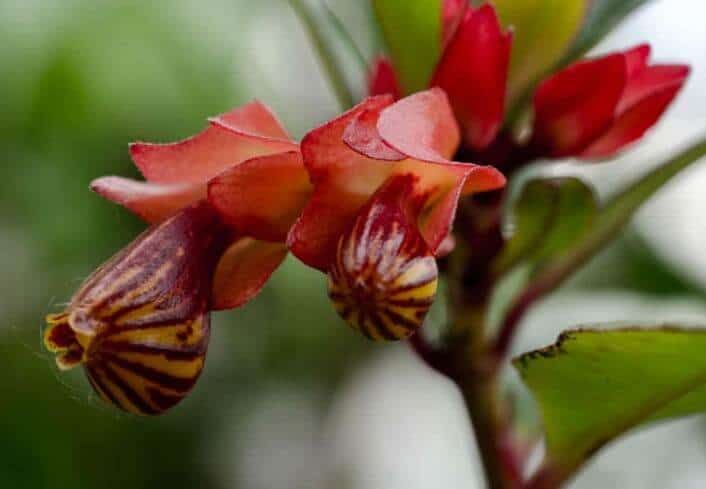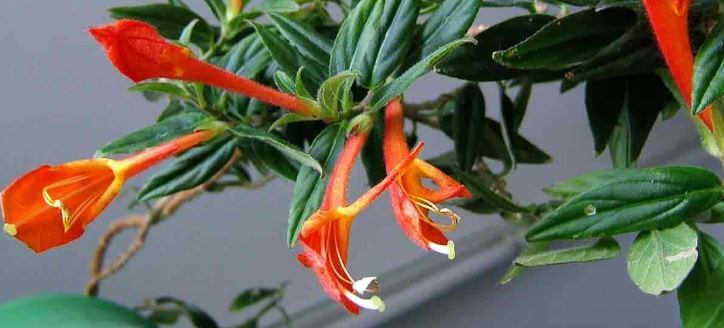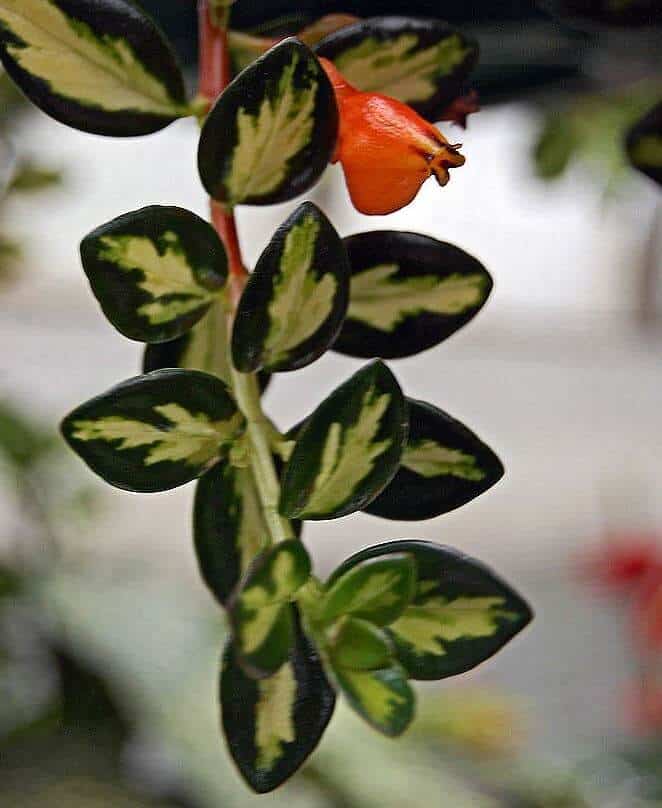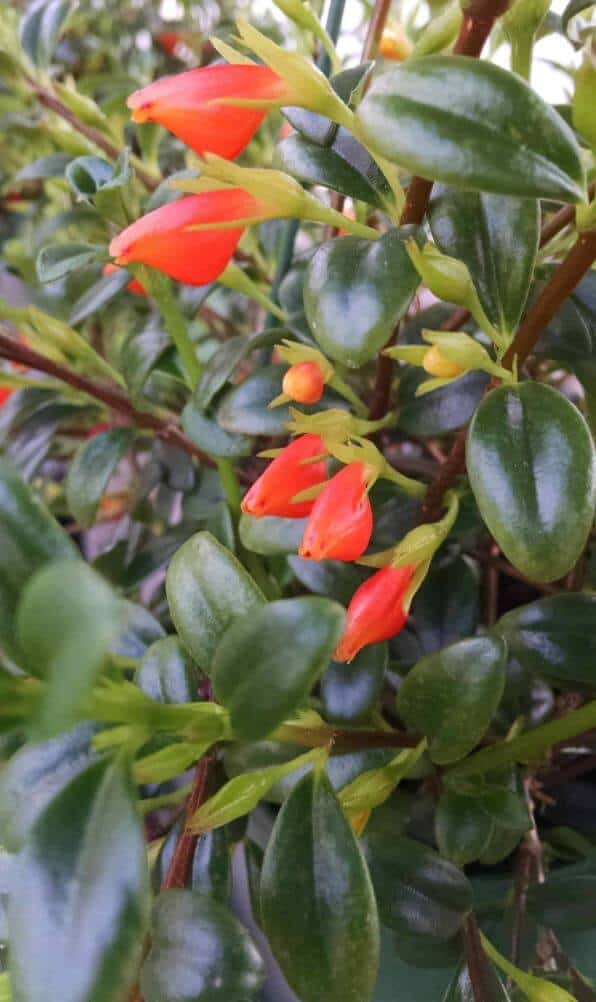Last Updated on September 9, 2023 by a Friendly Gardener
If you have a thing for colorful, attractive plants that resemble sea creatures, look no further than the variegated goldfish plant! This beautiful plant is the perfect choice for flowering tables or hanging plants, instantly highlighting the spot by adding a colorful flair to it.
Luckily, goldfish plants don’t need too much fussing, but they do need some amount of commitment and care. Here’s everything you need to know about variegated goldfish plants and caring for them.
About the Variegated Goldfish Plant

The variegated goldfish plant gets its name from its tiny goldfish-like red and orange flowers. Adding to the beauty of these scentless flowers is the perennial plant’s lovely variegated leaves.
Well taken care of, the combination of constant blooms and gorgeous leaves form a colorful riot of the best kind wherever they’re placed.
The goldfish plant features a short stem, typically three inches tall, with branches, some as long as three feet, extending from the main stem. The leaves are waxy, thick, shiny, and dark green, growing up to three feet in length, and in multitudes on each stem.
This decorative plant is a slow grower, but in the right conditions, can live for as long as ten years.
Another important feature to note about the variegated goldfish plants is that they are epiphytes, and not succulents, as commonly mistaken. This means that they need a host body to grow on, which is usually other plants or trees. They merely use the host as a supportive anchor and not for food, which means that they’re not parasites.
Goldfish plants bloom in the spring, producing tubular yellow, orange, or red flowers, and go dormant in the winter months, though some hybrid cultivars (there are over 25 varieties) flower throughout the year.
At a Glance

- Scientific Name: Columnea nematanthus
- Plant Type: Perennial epiphytes
- Other Names: Flying goldfish plant, goldfish plant variegated, guppy plant
- Genus: Columnea
- Family: Gesneriaceae
- Native to: Tropical Caribbean and American regions, such as Costa Rica, Southern Mexico, and Brazil
- Common Varieties: Columnea gregarious, variegated Columnea, Columnea gloriosa, Columnea Banksia, Columnea carnival
- Hardiness Zones: USDA zones 10b to 11b
- Toxicity: Goldfish plants are non-toxic to cats and dogs
Variegated Goldfish Plant Care
Variegated goldfish plant care is pretty easy. The following basic tips will help your variegated goldfish plant grow to its best.
Lighting Needs

The goldfish plant does well in indirect, bright light. During the growing season, a west-facing window makes an ideal spot, whereas, in the winter, a south-facing window is ideal.
You’re aiming for at least 12 hours of light, each day, for your goldfish plant.
Remember, when placing your plant near the window, don’t let it sit too close to the panes. Glass heats up and cools down intensely, so contact with the glass on extremely hot or cold days could scorch or freeze the leaves, depending on the season.
If you’re growing your plant indoors and there’s insufficient light, supplementing the existing light with grow lights or placing it directly under the existing lights can help, especially during the winter.
Humidity Needs
Goldfish plants thrive in extremely humid environments, requiring at least 50% to survive. If the air around the plant is drier than this, misting the leaves regularly with room-temperature water will help; cold water can lead to brown stains on the leaf surface.
You could also invest in a humidifier, especially in the winter months.
Temperature Needs
Since they’re native to tropical areas, goldfish plants like warm environments with a constant temperature between 65℉ and 75℉. These plants don’t do well near heaters or near cold drafts.
Watering Needs
Goldfish plants need regular watering, but you need to water just enough to slightly moisten the soil and not soak it. Allow the soil (the top six inches) to dry before you water the plant again. Purified water or rainwater is recommended to avoid the negative impacts of chlorine and fluoride on the plant.
It’s also essential that you don’t water your plants with cold water as this can shock the plant. Ensure that the water is at room temperature.
Overwatering can cause root rot to set in. A good way to judge whether your plant is getting sufficient water is to check its leaves. If the leaves are dropping off, it could mean that the plant is either getting too much or too little water.
During the winter, reduce the frequency of watering, but don’t wait for the soil to dry out completely, as you would the rest of the year.
Fertilizing Needs
Since they’re epiphytes and can grow on nearly any surface, goldfish plants can grow extremely well even without fertile soil. However, tiny amounts of phosphorus-rich fertilizer can help your plant grow better.
If you’re using said fertilizer, only apply it once every two weeks in the spring and summer months, diluting it with equal parts water. Better yet, you could opt for a water-soluble fertilizer.
If you plan to fertilize the plant in the winter, an application once a month (of liquid fertilizer) is recommended.
Remember, the amount of fertilizer required by the plant will vary between seasons, so don’t follow the same frequency of fertilizing in the winter that you would in the summer.
Soil Needs
Like most plants, goldfish plants need well-draining soil. Given their epiphytic nature, these plants don’t do well in the usual potting soil. Instead, use any gritty, light soil, such as African violet soil.
You could also make your own mix by combining peat moss, perlite, coco coir, and fir bark in equal proportions.
Potting and Repotting Needs
Goldfish plants need to be hung or planted in containers that have sufficient drainage holes, to prevent waterlogging and root rot.
Under normal circumstances, repotting your goldfish once every couple of years is sufficient, but if the soil is waterlogged or saturated with fertilizers, repotting is a must.
When you repot, opt for the next pot size and fresh soil mix. Repotting is best done in spring.
Propagating Your Goldfish Plant

Stem cuttings are the most efficient way to propagate goldfish plants. Choose a healthy plant to cut the stem from, and when you do, cut out two or three inches from a stalk that doesn’t have buds.
Place the cutting in a well-lit, humid environment till you see new growth. Use a rooting hormone for higher chances of success.
After four weeks, you should see roots developing, post which you can transfer the plant. However, you’ll have to wait till the summer for the new plant to bloom.
The Bottom Line
With the right care and maintenance, your variegated goldfish plant will reward you with gorgeous blooms throughout the year. Since these plants are drought-resistant and extremely easy to care for, they make excellent options for those who don’t have much time to spare for gardening or those with black thumbs!

